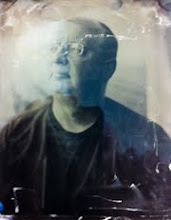Title: "View Alcatraz", San Francisco, October 2010
(click on image to view larger)
I've recently begun reading Harold Bloom's book "How to Read and Why", and he writes a number of things in the prologue that I think apply equally well to making art as they do to reading. Bloom writes:
"It matters, if individuals are to retain any capacity to form their own judgments and opinions, that they continue to read for themselves...why they read must be for and in their own interest...one of the uses of reading is to prepare ourselves for change..." Bloom goes on to fuse the wisdom of Bacon, Johnson and Emerson to say "find what comes near to you...that addresses you...then weigh and consider the nature it shares with you; its closeness to yourself."
It's not difficult to see that these are wise words to be considered by artists, or anyone interested in art. In order to educate ourselves to be able to form judgments and opinions, we need to be making art or carefully looking at and thinking about art. Being immersed in art as an artist or a viewer is an important part of the process of change, of expanding our understanding of the world and ourselves. Making art that speaks to us (or viewing art that speaks to us), and carefully considering how and why it makes that connection to us, is a way to deeper self-understanding. I think that in my own case, it is these common threads between reading and making art that bring me to constantly consider what story an artwork conveys to me - I often get a sense of narrative when looking at work I've made, even though it's been made without a specific narrative in mind.
Bloom goes on in the prologue to numerate five principles he feels are important to restore the way we should read. Again, I can readily see how these apply to making art:
1. Clear your mind of cant
(Cant referring to pious platitudes, the peculiar vocabulary of a sect or coven. One of the reasons I have reduced my interaction with internet sites like Flickr was to do exactly this, because I found myself being influenced too much by thinking of how work I posted would be "received")
2. Do not attempt to improve your neighbor by what or how you read
(In essence, rather than evangelize, spend the time making art. Here I see the analogy as being one of spend precious time making work rather than spend countless hours looking at other's work on the net, commenting on the work of others, evangelizing a specific point of view of how to make work)
3. A scholar is a candle which the love and desire of all men will light
(Bloom says that one's development as a reader is not selfish because it acts as an inspiration to others. The same can be said of the time taken for making art - good art inspires others to make art)
4. One must be an inventor to read well
(Bloom says "we read, frequently if unknowingly, in quest of a mind more original than our own". I take this principle to mean that we make art, often unknowingly, because we are constantly trying to realize the potential we each have to invent a new view of the world that surrounds us)
5. Recovery of the ironic
(Bloom mourns the loss of irony, because he sees it as the death of reading, and of that which has been civilized in our natures. In making art, there is plenty of scope to be ironic, or to accept the ironies that the process of art making constantly throws at us. Bloom goes on to state "Irony demands a certain attention span, and the ability to sustain antithetical ideas, even when they collide with one another". Just exactly what it takes to make art (attention span) that holds true meaning (antithetical ideas), with great excitement and satisfaction in the process (the collision of ideas))


No comments:
Post a Comment